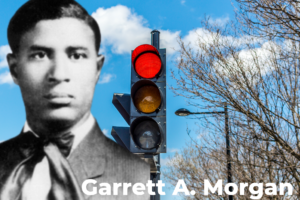Throughout the history of the United States, African Americans have made monumental contributions to the transportation industry through innovation and resiliency. This month we are honoring: Garrett Augustus Morgan, Frederick McKinley Jones, and Lois Cooper. In this article and across all of our communication platforms, the City of Durham’s Department of Transportation strives to make history seen while recognizing transportation history as a part of Black history.
Garrett Augustus Morgan  was the son of formerly enslaved people, the seventh child out of eleven, and the recipient of only an elementary school education. Born in Kentucky but raised in Ohio, he developed skills as a sewing machine mechanic. He later hired a tutor to enhance his education; however, the inner workings of machinery truly captured his eye, thus leading him into a prominent future as an inventor and entrepreneur. After blazing several trails as an African American inventor and patent holder, Morgan developed one of the greatest inventions for the transportation industry in 1923. As the first Black man to own a car in Cleveland, Ohio, Garrett witnessed a carriage accident at a high traffic intersection. With the aspiration of an inventor, Mr. Morgan created a warning light designed to alert drivers to stop at intersections. His invention in the present day is the traffic light.
was the son of formerly enslaved people, the seventh child out of eleven, and the recipient of only an elementary school education. Born in Kentucky but raised in Ohio, he developed skills as a sewing machine mechanic. He later hired a tutor to enhance his education; however, the inner workings of machinery truly captured his eye, thus leading him into a prominent future as an inventor and entrepreneur. After blazing several trails as an African American inventor and patent holder, Morgan developed one of the greatest inventions for the transportation industry in 1923. As the first Black man to own a car in Cleveland, Ohio, Garrett witnessed a carriage accident at a high traffic intersection. With the aspiration of an inventor, Mr. Morgan created a warning light designed to alert drivers to stop at intersections. His invention in the present day is the traffic light.
Frederick McKinley “Casey” Jones  ran away from home at age 11 after experiencing multiple hardships early on. While navigating the world independently in between unusual working opportunities, he allocated his free time to learn more about mechanical and electric engineering by teaching himself. His commitment to advancing his knowledge derived from him being a voracious reader. In 1912, he relocated to Minnesota, where he worked on a farm as a mechanic. At age 20, he obtained a license in engineering. After serving in World War I as a machine repairman, he returned to the farm in Minnesota. In the 1930s, his thirst for knowledge expanded into developing a portable air-cooling unit for trucks and railroad cars to transport food and other perishable items. He later formed a partnership with Numero and founded the U.S. Thermo Control Company, and by 1949 his company was worth millions. After obtaining 61 patents, he received many awards and honors, including the National Medal of Technology.
ran away from home at age 11 after experiencing multiple hardships early on. While navigating the world independently in between unusual working opportunities, he allocated his free time to learn more about mechanical and electric engineering by teaching himself. His commitment to advancing his knowledge derived from him being a voracious reader. In 1912, he relocated to Minnesota, where he worked on a farm as a mechanic. At age 20, he obtained a license in engineering. After serving in World War I as a machine repairman, he returned to the farm in Minnesota. In the 1930s, his thirst for knowledge expanded into developing a portable air-cooling unit for trucks and railroad cars to transport food and other perishable items. He later formed a partnership with Numero and founded the U.S. Thermo Control Company, and by 1949 his company was worth millions. After obtaining 61 patents, he received many awards and honors, including the National Medal of Technology.
Lois Cooper  was born in 1931. After growing up in Mississippi, she attended Tougaloo College, a small but prominent Historically Black College. She later moved to California to be closer to her mother. Lois attended Los Angeles City College and Los Angeles State College to study mathematics with a commitment to advance her education further. Many times she was recognized as the only Black woman in her classes. Upon graduation, she planned to begin her career at the Department of Agriculture. However, they mistook her for a male, making her seek work elsewhere as an engineering aide at Caltrans. Shortly after that, she became the first Black woman to obtain a professional engineer’s license in 1953. As she rose in her career, she made history once more after becoming the first African American female transportation engineer to work at the California Department of Transportation. She worked on significant projects throughout her career, including the I-105 Century Freeway, the San Diego Freeway, the Long Beach Freeway, the San Gabriel River Freeway, and the Riverside Freeway.
was born in 1931. After growing up in Mississippi, she attended Tougaloo College, a small but prominent Historically Black College. She later moved to California to be closer to her mother. Lois attended Los Angeles City College and Los Angeles State College to study mathematics with a commitment to advance her education further. Many times she was recognized as the only Black woman in her classes. Upon graduation, she planned to begin her career at the Department of Agriculture. However, they mistook her for a male, making her seek work elsewhere as an engineering aide at Caltrans. Shortly after that, she became the first Black woman to obtain a professional engineer’s license in 1953. As she rose in her career, she made history once more after becoming the first African American female transportation engineer to work at the California Department of Transportation. She worked on significant projects throughout her career, including the I-105 Century Freeway, the San Diego Freeway, the Long Beach Freeway, the San Gabriel River Freeway, and the Riverside Freeway.
In essence, we can view Black History in three ways: with, within, and without:
We can honor the stories we may have never known before with recognition.
We can explore new heights within transportation to connect us to where we are now.
Without it, we can comprehend the gaps inside cutting-edge technology created by Black innovators who pressed on beyond all adversities.
Today and always, we will educate, celebrate and recognize Black History. Happy Black History Month!

